

19 Questions to Ask at Your Next Doctor's Appointment
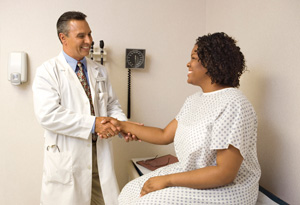
Primary Care Physician Checklist
- Blood Pressure Ask what it is and what it should be.
- Family History Discuss when you should be tested for diseases that have affected family members.
- Blood tests Starting between ages 35 and 40, you should have your cholesterol and blood-sugar levels checked to screen for heart disease and diabetes. Ask ahead if you need to make preparations, such as fasting before the test.
- Thyroid Function Women should have their thyroid tested every five years after menopause. You also should be tested if you have unexplained weight loss, irritability, irregular heart rate, insomnia or muscle weakness (all symptoms of an overactive thyroid), or fatigue, depression, weight gain, dry skin or trouble concentrating (all signs of an underactive thyroid).
- Bone Mineral Density (BMD) You should have a BMD test at age 65 (sooner if you are postmenopausal and have risk factors: for instance, you're thin or small boned, or you smoke or have a family history).
- Prescriptions Tell your doctor about any other drugs, herbs or supplements you're taking.
- Unusual Symptoms Describe anything abnormal—a rash, headaches, sadness, sudden weight gain or loss, fatigue.
Gynecologist Checklist
- Contraception Ask whether you're using the right form for you. For example, the pill might not be the best option if you smoke, are physically inactive, and are over 35.
- Sexually Transmitted Diseases (STDs) Testing for STDs is not part of the Pap smear; ask your doctor which STDs (HIV, chlamydia, or gonorrhea, for example) you should be screened for.
- Mammograms You should get one annually, starting at age 40 (earlier if you have a family history of breast cancer).
- Pap Smear Ask for the new ThinPrep test, which more accurately shows cell abnormalities. Your doctor takes the sample the usual way, then dips it into a solution that breaks down the mucus, blood and inflammation that can make it hard to see the cervical cells.
- Human Papillomavirus (HPV) New guidelines suggest that if your results are inconclusively abnormal (called ASC-US), you should be tested for HPV strains that can cause cervical cancer.
- Fibroids Tell your doctor if you've had heavier or more-painful-than-usual periods, which may be a sign of fibroids.
- The Rest of the Exam Your visit should include a pelvic and rectal exam to check for signs of vaginal infections, uterine fibroids, STDs or ovarian cysts.
Dentist Checklist
- X-rays Patients should get a complete set of X-rays every three to five years. During regular checkups—which should be scheduled every six months to a year—X-rays should be taken of individual teeth that may have cracks or cavities. Pregnant women should not have X-rays.
- Temporomandibular Joint (TMJ) Syndrome Clenching, grinding, or bad alignment of teeth can cause this disorder. Even if you don't notice symptoms (headaches, jaw pain), your dentist should look at your bite and feel your jaw to ensure there is no stress to the joints.
- Periodontal Exam Have your gums receded? Your dentist should take measurements annually around each tooth to detect any gum disease.
- Oral Cancer The inside of your mouth and the glands in your neck area should be checked each year.
- Oral Surgery Anytime you receive general anesthesia, an oral surgeon, a surgical assistant and another assistant should be on hand to monitor your vital signs using an EKG, a blood pressure monitor and a pulse oximeter. Either the oral surgeon must be licensed in anesthesiology by the state dental board (the license should be displayed in the office) or there must be an anesthesiologist present.
- 11 doctor's appointments to make at every age
- Cost-saving secrets from doctors' offices
- How to get the best medical care

WATCH OWN APP
Download the Watch OWN app and access OWN anytime, anywhere. Watch full episodes and live stream OWN whenever and wherever you want. The Watch OWN app is free and available to you as part of your OWN subscription through a participating TV provider.
NEWSLETTERS
SIGN UP FOR NEWSLETTERS TODAY AND ENJOY THE BENEFITS.
- Stay up to date with the latest trends that matter to you most.
- Have top-notch advice and tips delivered directly to you.
- Be in the know on current and upcoming trends.
OPRAH IS A REGISTERED TRADEMARK OF HARPO, INC. ALL RIGHTS RESERVED © 2024 HARPO PRODUCTIONS, INC. ALL RIGHTS RESERVED. OWN: OPRAH WINFREY NETWORK
Call us to talk to a Registered Nurse
1.866.KINDRED | 1.866.546.3733
For Healthcare Questions call 1.866.KINDRED
Your Complete Checklist to Prepare for Doctor’s Visits
If you are living with one or more chronic conditions, it can seem like your calendar is full of doctor’s appointments. Try these tips to make the most of each visit by good preparation, being thorough during your visit and how to have a good follow-up plan.

Prepare for Your Appointment
- Write down everything you want to tell or ask the physician.
- Arrive early to your physician as you may need to complete forms.
- Bring a list of your symptoms (when they started, how long they last, how they feel, and where they are).
- Bring a list of any changes in your routine (for example: diet, exercise or activity, sleeping patterns).
- Bring a brown bag of all your medications you now take. Include prescription and over‐the‐counter medications (vitamins, herbal, mineral supplements).
- Bring your insurance cards and your updated information sheets.
- Bring your Patient Health Record that includes a list of other physicians taking care of you and recent physician visits with any changes in medications by that physician and tests or procedures performed.
- Bring your daily monitoring log if you use one (blood pressure/heart rate log, diet log, activity log, blood sugar log).
During Your Visit
- Don’t let yourself be rushed. Go over your questions and concerns.
- Communicate your symptoms and changes in routine. Make sure you describe how you feel and how long the changes have occurred.
- Don’t withhold information. Physicians cannot help you if you do not tell them!
- Communicate any symptoms related to your medications (i.e. dizziness, lightheadedness, dry mouth, headache, palpitations, stomach upset and bowel changes).
- Answer the physician’s questions honestly. Physicians depend on your input to help them diagnose your condition and prescribe treatment for you.
- Get clarification. Ask about anything that is unclear.
- Write down the physician’s answers and directions. If you have difficulty writing or anticipate being too worried to “hear and understand things,” consider taking a family member or friend along.
- If the physician orders tests, learn their purpose and if there are any risks. Ask how you should prepare for the tests.
- If the physician prescribes medication, be sure you understand its benefits and risks, as well as how to take and store it.
- If your physician has prescribed treatments for your condition ask questions such as: Is there more than one treatment? What are the pros and cons of each treatment? With which treatments have you had the most success?
- Ask for patient education materials. To learn more about any condition, ask for easy‐to‐follow educational pamphlets or video tapes.
- Ask when you should schedule a follow‐up visit. Make an appointment prior to leaving the physician office.
Follow‐up after Your Physician Visit
- Call for additional information. If your still have questions, do not hesitate to phone your physician to discuss them.
- Take time to learn your new medications or change in medication dose safely. If you have questions, do not hesitate to phone your physician to ask.
- Report any symptoms that occur after any new changes in treatment or medications.
- Update your Patient Health Record. Keep your Patient Health Record current to reflect your physicians’ visits, medical conditions, tests or procedures performed, and treatment.
- Update your medication schedule with any new medications or changes in medication dosage or time to administer.
- Always follow up. It is your responsibility to follow up with your physician to find out test or procedure results. Don’t wait for your physician to call you.
If leaving home to go to doctor’s appointments is becoming more difficult, call 1.866.KINDRED (1.866.546.3733) to speak with a Registered Nurse 24 hours a day, seven days a week. Care at home may be an option for you.

Recent Posts
- In Case of Emergency... How a Cell Phone Can Save Your Life
- Cold Weather and COPD
- Raising Awareness Around Alcohol and Drug Addiction in September
- Recovery and Rehabilitation After a Hospital Stay
- Stories of Caring: Judith Stayed by George’s Side After a Catastrophic Accident
We're Social
Free webinar May 9: How to spot and stop a scam. Sign up now.
AARP daily Crossword Puzzle
Hotels with AARP discounts
Life Insurance
AARP Dental Insurance Plans
AARP MEMBERSHIP — $12 FOR YOUR FIRST YEAR WHEN YOU SIGN UP FOR AUTOMATIC RENEWAL
Get instant access to members-only products and hundreds of discounts, a free second membership, and a subscription to AARP the Magazine.
- right_container
Work & Jobs
Social Security
AARP en Español
- Membership & Benefits
- AARP Rewards
- AARP Rewards %{points}%
Conditions & Treatments
Drugs & Supplements
Health Care & Coverage
Health Benefits

Staying Fit
Your Personalized Guide to Fitness

AARP Hearing Center
Ways To Improve Your Hearing

Brain Health Resources
Tools and Explainers on Brain Health

A Retreat For Those Struggling
Scams & Fraud
Personal Finance
Money Benefits

View and Report Scams in Your Area

AARP Foundation Tax-Aide
Free Tax Preparation Assistance

AARP Money Map
Get Your Finances Back on Track

How to Protect What You Collect
Small Business
Age Discrimination

Flexible Work
Freelance Jobs You Can Do From Home

AARP Skills Builder
Online Courses to Boost Your Career

31 Great Ways to Boost Your Career

ON-DEMAND WEBINARS
Tips to Enhance Your Job Search

Get More out of Your Benefits

When to Start Taking Social Security

10 Top Social Security FAQs

Social Security Benefits Calculator

Medicare Made Easy
Original vs. Medicare Advantage

Enrollment Guide
Step-by-Step Tool for First-Timers

Prescription Drugs
9 Biggest Changes Under New Rx Law

Medicare FAQs
Quick Answers to Your Top Questions
Care at Home
Financial & Legal
Life Balance

LONG-TERM CARE
Understanding Basics of LTC Insurance

State Guides
Assistance and Services in Your Area

Prepare to Care Guides
How to Develop a Caregiving Plan

End of Life
How to Cope With Grief, Loss
Recently Played
Word & Trivia
Atari® & Retro
Members Only
Staying Sharp
Mobile Apps
More About Games

Right Again! Trivia

Right Again! Trivia – Sports

Atari® Video Games

Throwback Thursday Crossword
Travel Tips
Vacation Ideas
Destinations
Travel Benefits

Beach vacation ideas
Vacations for Sun and Fun

Plan Ahead for Tourist Taxes

AARP City Guide
Discover Seattle

25 Ways to Save on Your Vacation
Entertainment & Style
Family & Relationships
Personal Tech
Home & Living
Celebrities
Beauty & Style

TV for Grownups
Best Reality TV Shows for Grownups

Robert De Niro Reflects on His Life

Looking Back
50 World Changers Turning 50

Sex & Dating
Spice Up Your Love Life

Navigate All Kinds of Connections

Life & Home
Couple Creates Their Forever Home

Store Medical Records on Your Phone?

Maximize the Life of Your Phone Battery

Virtual Community Center
Join Free Tech Help Events

Create a Hygge Haven

Soups to Comfort Your Soul

Your Ultimate Guide to Mulching
Driver Safety
Maintenance & Safety
Trends & Technology

AARP Smart Guide
How to Keep Your Car Running

We Need To Talk
Assess Your Loved One's Driving Skills

AARP Smart Driver Course

Building Resilience in Difficult Times

Tips for Finding Your Calm

Weight Loss After 50 Challenge

Cautionary Tales of Today's Biggest Scams

7 Top Podcasts for Armchair Travelers

Jean Chatzky: ‘Closing the Savings Gap’

Quick Digest of Today's Top News

AARP Top Tips for Navigating Life

Get Moving With Our Workout Series
You are now leaving AARP.org and going to a website that is not operated by AARP. A different privacy policy and terms of service will apply.
The Doctor Will See You Now: In-Person Visits Slowly Resume
What to expect, how to prepare for a nonurgent appointment.

Rachel Nania,
Busy medical waiting rooms are likely a thing of the past. Since the start of the coronavirus outbreak, doctors’ offices throughout the country have scaled back staff, postponed preventive appointments and switched in-person visits to online video chats as much as possible.
However, as states begin to ease their stay-at-home restrictions , medical offices are doing the same by opening their doors to more patients with nonurgent medical needs. Here's what to expect when you need medical care now.

AARP Membership — $12 for your first year when you sign up for Automatic Renewal
Can I go to my doctor's office? Depends on where you live
It's important to note that physicians’ offices haven't closed due to the coronavirus. Many have remained open to “see patients that they thought really needed to come in,” says Patrice Harris, a psychiatrist and president of the American Medical Association (AMA). It's just that now, some are starting to take on less critical visits, as well. But that, of course, depends on where you live.
Skipping care during the coronavirus outbreak
Nearly half of American adults (48 percent) say they or someone in their household have postponed or skipped medical care due to the coronavirus outbreak, according to a new poll from the Kaiser Family Foundation . And about 11 percent of those who missed out on medical appointments say their condition worsened as a result.
However, as stay-at-home restrictions ease and medical offices resume more routine appointments, most of those who avoided the doctor’s office during the first few months of the pandemic (68 percent) plan to make up for the delayed care in the next three months.
Doctors in Virginia, for example, received the green light to resume non-emergency care at the beginning of May; practices in Oregon and Alaska have also started welcoming nonurgent patients back to their offices.
One Medical, a primary care group with locations nationwide, recently started accepting more routine in-person appointments in its Northern California offices. Other sites are expected to follow, with the exception of New York. “The real distinction there is that the prevalence of community spread of COVID in New York is a very unique environment in terms of the volume of spread,” says Leah Rothman, a family physician and regional medical director for One Medical in Northern California.
The “reopening processes will vary,” community by community, based on “the evidence and the data around COVID-19,” Harris says. Physician practices are “following state and local public health guidelines,” and are “working with state and local health officials,” she adds.
The best thing to do is to call your doctor's office to discuss what is ideal for your particular situation. Even if your physician has started physically seeing more patients, she or he may still prefer a telehealth visit. If the doctor wants to see you in person, the staff will likely want to walk you through any new rules and safety precautions.

Join AARP today for $16 per year. Get instant access to members-only products and hundreds of discounts, a free second membership, and a subscription to AARP The Magazine.
ARTICLE CONTINUES AFTER ADVERTISEMENT
"Physicians do not want our patients to think that they are alone in trying to figure out when to come to the doctor,” Harris says. “We definitely want them to call in.”
‘The new normal': Temperature checks, masks, waiting in your car
William Anderson, who oversees a 90-physician practice in Northern Virginia, says he and his fellow doctors started increasing in-office appointments two weeks ago, and they have met the “significant pent-up demand” with several safety precautions.
Some of these measures are predictable — all patients must wear masks and are screened for fever and other symptoms of COVID-19, the illness caused by the coronavirus. Other changes are more innovative. For example, Anderson's practice has practically eliminated the traditional waiting room, and instead encourages patients to wait in their cars until they receive a text from the office to come in for their appointment.
"It's allowed us to leverage technology to make it more convenient,” Anderson says. “You can come in the door and go right back to the exam rooms. You don't have to wait.” Preregistration and advance checkout also eliminate the need to stand in a line with others before and after your appointment. “And I think that adds to the convenience and access,” he says.
Some practices will space out appointments to keep the number of people in the office to a minimum, making it easier for everyone to keep their distance from others, the AMA's Harris says. The AMA also recommends that doctors limit the number of visitors who come with a patient to an appointment, so be sure to ask about any new rules when you schedule your visit.
"The new normal is going to be the new normal for a long time, and it will be different,” Harris says.
How to prepare for a doctor visit
You can do a few things ahead of your appointment to ensure your in-person visit goes smoothly. Anderson recommends packing a cloth face covering and some hand sanitizer for when you don't have immediate access to soap and water. It's also a good idea to write down your health conditions and the medications you take ahead of time so you don't leave any off during your visit. And don't forget to include any drug allergies you may have.
"It's important for providers particularly to know if you have diabetes or if you are immunocompromised, for example. So from a patient standpoint, keep that information and carry some protective equipment with you,” Anderson says.
Without a vaccine, risk for exposure to the coronavirus can be anywhere. But if patients and staff follow the safety precautions put in place, a trip to the doctor's office should be a relatively safe experience. “It's probably more dangerous to go to a grocery store than it is to come and see us in our office,” Anderson adds.
AARP® Dental Insurance Plan administered by Delta Dental Insurance Company
Dental insurance plans for members and their families
When to go to the emergency room
In addition to a decline in routine visits in the last few months, physicians’ offices have also noticed a steep decline in the number of patients coming in for acute care. Hospital emergency rooms across the country have also reported a marked drop in visits since the start of the coronavirus outbreak — and experts say this is a concerning trend.
"I know that folks have been worried about going to the emergency department, but if they would have thought of calling 911 before COVID-19, they should remember that they should continue to do that during this pandemic,” Harris says.
Difficulty breathing, difficulty speaking, chest or upper abdominal pain, uncontrolled bleeding and changes in vision all warrant trips to the emergency room, according to the American College of Emergency Physicians. Injuries such as twisted ankles or noncompound fractures can often be taken care of in a physician's office or urgent care center, Anderson says. But it's always a good idea to call ahead to make sure.
"We don't want anybody to delay those things, because delayed primary care actually turns into emergencies,” One Medical's Rothman adds.
Telehealth is here to stay
Even with routine appointments back up and running in some areas, telehealth is expected to stick around. That method of health care delivery has “expanded rapidly during the crisis,” according to the nonpartisan Kaiser Family Foundation. In mid-April, the Cleveland Clinic reported that demand for virtual visits was up more than 1,000 percent since the start of the outbreak. Other polls have found that more than 20 percent of adults have used telehealth services during the pandemic.
"I think telehealth is here to stay because of the convenience and access piece of it,” Anderson says. “It also allows us to do some interesting things with care management for chronic disease … it allows us virtual triage options, and I think it will show a reduced cost of care in the long run because patients have more available access to ask questions and get the care that they need” virtually.
That said, telehealth will never replace in-person visits, Harris says. Instead, it will likely “be integrated into our overall new health ecosystem.”
"There will continue to be a role for telehealth, but we will have to make sure that role is in the service of patients and that we continue to see good outcomes,” Harris adds.
More on health

Availability of Primary Care Doctors Boosts Overall Life Expectancy

How Often Do You Really Need to Go to the Doctor?
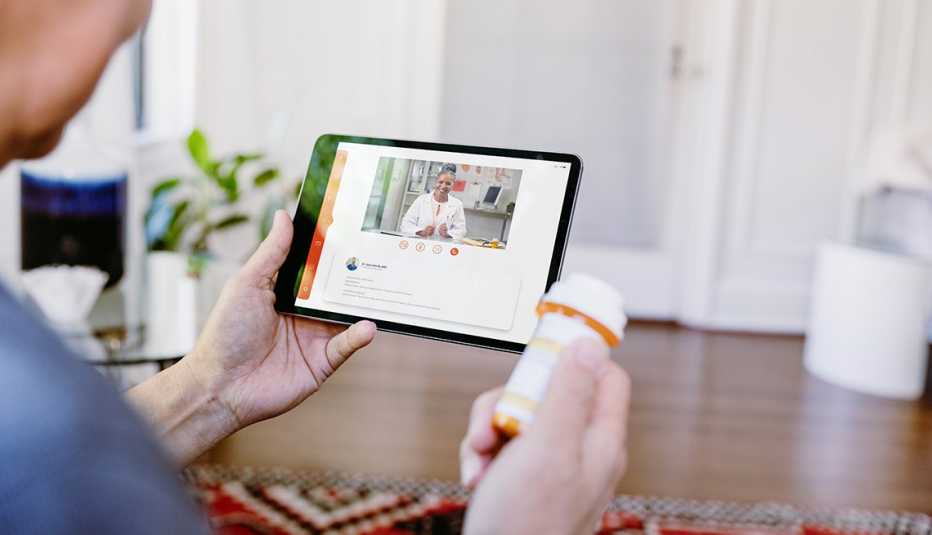
How Caregivers Can Handle Rising Health Care Expectations During the Pandemic
Discover AARP Members Only Access
Already a Member? Login
AARP VALUE &
MEMBER BENEFITS

Denny's
15% off dine-in and pickup orders

AARP Travel Center Powered by Expedia: Vacation Packages
$50 gift card of your choice when booking any flight package

$20 off a Walmart+ annual membership

AARP® Staying Sharp®
Activities, recipes, challenges and more with full access to AARP Staying Sharp®
SAVE MONEY WITH THESE LIMITED-TIME OFFERS

- Prepare for Doctor Visits and Make a List of Questions
Prepare a list of questions and symptoms before you visit your doctor or go for a procedure or to the hospital. A doctor won’t be able to answer your questions if you don’t ask.
Bring a List of Questions
Do you ever get home from a doctor visit and suddenly think of a burning question you wish you’d asked during your visit an hour earlier? This is the case for a lot of people. It helps to think ahead of time about the reason for your visit and what you hope to get out of it. Talk it over with a friend or family member. You may find yourself with a list of questions. Bring them to your appointment and jot down the answers.
Learn more in this Take 5 podcast as Lisa DiBlasi Moorehead discusses why it’s important for a patient to play an active role in their care and be open and honest about symptoms, what to bring with to provider visits and what do to after a visit. Lisa DiBlasi Moorehead, EdD, MSN, RN, CENP is the Associate Nurse Executive in the division of Accreditation and Certification Operations at The Joint Commission.
Preparing for Virtual Visits
In today’s new normal, preparing for a doctor’s visit may look a little different and require additional preparation. As COVID-19 increases social distancing across the U.S., it’s no surprise that virtual medical appointments have seen a huge spike in popularity. Telemedicine isn’t new, but it’s been utilized more than ever during this stressful time of quarantine and self-isolation. Here are some ways to plan for a successful virtual visit.
In Person Visits
Health care facilities, such as hospitals, doctors’ offices, surgery centers and all sites of care are reopening as appropriate, and as state and local conditions allow. Precautions are being taken to ensure your care is safe and that you are protected. Patients should have confidence in seeking care, and trust that your health care providers are doing their best to keep you, your family, and your community safe. Therefore, you should not postpone necessary care or preventative care such as immunizations or cancer screening. Do not hesitate to reach out to your provider if you have any questions about when to seek treatment.
To prevent you from getting COVID-19, or giving it to others, you may be asked to do the following by your provider:
- Wear a face covering. This helps limit your risk of getting or spreading COVID-19.
- Avoid crowded waiting areas. Some practices may require patients to check in for their appointment from their car. You may be asked to wait in your car until your visit. Waiting rooms should have chairs spaced far apart to keep you and others safe.
- Limit visitors or people who go to your appointment with you. Be prepared that you may not be allowed to bring anyone with you and if you typically accompany an elderly family member, you may be asked to wait in the car. Limiting the number of people limits your exposure. Visitors should also wear a face covering.
- Screening before entering a facility. Your temperature may be taken, and you may be asked to use hand sanitizer and wear gloves. The office may call you a few days before your appointment to go over some screening questions. This means asking questions about your possible risk factors of having COVID-19. They may repeat these questions during your visit. You may also be asked additional information over the phone to reduce the amount of paperwork needed at the time of visit.
Discuss with your provider if you should get tested before going in for care. In some cases, such as before surgery, childbirth, or a procedure, it may be necessary to be tested for COVID-19.
Resources and Tools:
- Share symptoms with your doctor (STARS tool)
- Speak Up About Your Care
- Speak Up At the Doctor’s Office
- Visit the TakeCharge website
- Take 5: The TakeCHARGE Campaign’s 5 Steps to Safer Health Care – Preparing for Provider Visits
- Understand and Complete Your Advance Directives
- Keep a Record of Your Medical History and Current Medications
- Prevent Infections and Ask Caregivers to Wash Their Hands
- Use an Advocate or Be an Advocate for Others
- Bipolar Disorder
- Therapy Center
- When To See a Therapist
- Types of Therapy
- Best Online Therapy
- Best Couples Therapy
- Best Family Therapy
- Managing Stress
- Sleep and Dreaming
- Understanding Emotions
- Self-Improvement
- Healthy Relationships
- Student Resources
- Personality Types
- Guided Meditations
- Verywell Mind Insights
- 2023 Verywell Mind 25
- Mental Health in the Classroom
- Editorial Process
- Meet Our Review Board
- Crisis Support
What Happens During a Wellness Visit?
Sanjana is a health writer and editor. Her work spans various health-related topics, including mental health, fitness, nutrition, and wellness.
:max_bytes(150000):strip_icc():format(webp)/SanjanaGupta-d217a6bfa3094955b3361e021f77fcca.jpg)
Steven Gans, MD is board-certified in psychiatry and is an active supervisor, teacher, and mentor at Massachusetts General Hospital.
:max_bytes(150000):strip_icc():format(webp)/steven-gans-1000-51582b7f23b6462f8713961deb74959f.jpg)
Jose Luis Pelaez / Getty Images
Importance of a Wellness Visit
- What to Expect
- How to Prepare
A wellness visit is a health check-up that is typically conducted on an annual basis. It involves visiting your healthcare provider to check your vitals, screen for health conditions , and develop a healthcare plan for your needs.
The aim of a wellness visit is to promote health and prevent disease and disability.
This article explains why annual wellness visits are important, what you can expect during the process, and how to prepare for it.
These are some reasons why wellness visits are important.
Prevent Diseases
Most healthcare visits are categorized under diagnostic care; when you have a health problem, you visit a healthcare provider who assesses your symptoms, diagnoses your condition, and prescribes a treatment plan.
A wellness visit on the other hand is a preventative healthcare measure. The aim of preventative healthcare is to help you maintain good health and prevent health problems before they develop. The goal is to help you live a longer, healthier life.
Wellness visits assess your lifestyle, evaluate health risks, and screen for health conditions, in order to prevent health problems or catch them in the early stages. Instead of waiting to see a healthcare provider once you have a health problem, the idea is to be proactive about your health and work with your healthcare provider to prevent health problems.
People tend to think that it’s fine to skip their annual wellness visit if they’re feeling healthy. However, a 2021 study notes that wellness visits can play a role in catching chronic health conditions early, as well as helping people control for risk factors that could cause them to develop health issues down the line.
Reduce Medical Costs
Wellness visits can help prevent disease and disability, which in turn can help reduce medical costs. According to a 2016 study, a focus on preventive healthcare can significantly reduce medical costs and improve the quality of healthcare services.
What to Expect During a Wellness Visit
A wellness visit may be performed by a healthcare provider such as a doctor, nurse practitioner, clinical nurse specialist, physician assistant, or other qualified health professional.
These are some of the steps a wellness visit may involve:
- Family history: Your healthcare provider may ask you detailed questions about your family’s medical history, to determine whether you are at an increased risk for certain health conditions that may be passed on genetically .
- Medical history: You may also be asked questions about your personal medical history. It can include information about any current or previous diseases, allergies, illnesses, surgeries, accidents, medications, vaccinations, and hospitalizations, as well as the results of any medical tests and examinations.
- Measurements: Your healthcare provider may measure your height, weight, heart rate, blood pressure, and other vital signs. Doing this regularly can help you establish a baseline as well as track any changes in your health.
- Cognitive assessment: Your healthcare provider may assess your ability to think, remember, learn, and concentrate, in order to screen for conditions such as Alzhemer’s disease and dementia.
- Mental health assessment: Your healthcare provider may also assess your mental health and state of mind, to help screen for conditions such as depression and other mood disorders.
- Physical assessment: Your healthcare provider may perform a physical examination to check your reflexes. They may also perform a neurological exam, a head and neck exam, an abdominal exam, or a lung exam.
- Functional assessment: Your healthcare provider may assess your hearing, your vision, your ability to perform day-to-day tasks, your risk of falling, and the safety of your home environment.
- Lifestyle factors: Your healthcare provider may ask you questions about your nutrition, fitness, daily habits, work, stress levels, and consumption of substances such as tobacco, nicotine, alcohol, and drugs.
- Health risk assessment: Based on this information, your healthcare provider will evaluate your health, and determine whether you are at an increased risk for any health conditions.
- Health advice: Your healthcare provider may advise you on steps you can take to improve your health, control risk factors, and prevent disease and disability. This may include nutrition counseling, an exercise plan, flu shot and vaccination recommendations, and fall prevention strategies, among other things.
- Screenings: Your healthcare provider may recommend that you get screened for certain health conditions such as depression , cholesterol, blood pressure, diabetes, cancer, heart disease, or liver conditions. This may involve blood work, imaging scans, or other screening tests.
- Medication review: Your healthcare provider may review your medication and adjust it, if required. This can include prescription medication, over-the-counter medication, vitamins, supplements, and herbal or traditional medication.
- Referrals and resources: If required, your healthcare provider will provide a referral to other healthcare specialists. They can also provide other resources that may be helpful, such as counseling services or support groups , for instance.
- Medical providers: Your healthcare provider will work with you to create or update a list of your current medical providers and equipment suppliers. This list can be helpful in case of an emergency.
- Healthcare plan: Your healthcare provider will work with you to create a healthcare plan that is tailored to your needs. The plan will serve as a checklist that will list any screenings or preventive measures you need to take over the next five to 10 years.
The screenings, assessments, and healthcare plan can vary depending on factors such as your age, gender, lifestyle, and risk factors.
How to Prepare for a Wellness Visit
These are some steps that can help you prepare for a wellness visit:
- Fill out any required questionnaires: Your healthcare provider may ask you to fill out a questionnaire before your visit. The questionnaire may include some of the factors listed above. Make sure you do it before your visit, so that you can make the most of your time with your healthcare provider.
- Carry your medications: If possible, try to carry your medications with you to show them to your healthcare provider.
- Take your medical documents along: It can be helpful to carry your prescriptions, immunization records, as well as the results of any medical tests or screenings you have had, to help give your healthcare provider a more accurate picture of your health status.
- Ask someone to go with you: You may want to take a trusted friend or family member along with you for the wellness visit. They can assist you if required, take notes for you, ask questions, and help you remember your healthcare provider’s instructions.
- Note down questions and concerns: A wellness visit is a good opportunity to ask your healthcare provider any questions you have about your health and tell them about any health problems or concerns you have. Making a list and carrying it with you to the visit can help ensure that you don’t miss anything.
- Check your insurance plan: Most insurance plans cover wellness visits; however, what is covered as part of the wellness visit can vary depending on the plan. It can be helpful to know what preventative services and wellness visits your plan offers. It’s important to check that your healthcare provider takes your insurance and to inform them that you’ll be coming for a wellness visit when you schedule your appointment.
A Word From Verywell
A wellness visit can help you evaluate your health status, understand your risk for specific health conditions, and give you the information and resources you need to improve your health.
After you go for a wellness visit, it’s important that you start implementing your healthcare provider’s advice, take any follow-up appointments necessary, and take steps to improve your health.
U.S. Department of Health and Human Services. Get your wellness visit every year .
University Hospitals. What you need to know about wellness visits .
Liss DT, Uchida T, Wilkes CL, Radakrishnan A, Linder JA. General health checks in adult primary care: a review . JAMA . 2021;325(22):2294-2306. doi:10.1001/jama.2021.6524
Musich S, Wang S, Hawkins K, Klemes A. The impact of personalized preventive care on health care quality, utilization, and expenditures . Popul Health Manag . 2016;19(6):389-397. doi:10.1089/pop.2015.0171
Alzheimer’s Association. Annual wellness visit .
University of Michigan Health. Your yearly wellness visit .
By Sanjana Gupta Sanjana is a health writer and editor. Her work spans various health-related topics, including mental health, fitness, nutrition, and wellness.

- Health Care Home
- Patient & Family Services
Pre-Visit Checklist: Complete Digitally Before Your Appointment
Speed up your appointment: complete your pre-visit checklist via phone or online.
Before you arrive at your appointment you can complete your pre-visit checklist. Complete this checklist by logging in to your MyChart account and check and update your information if necessary.
On December 4, 2022, you will not need have a MyChart account. Any patient can complete their previsit checklist online.
On the day of your appointment, when you arrive at the clinic, you can finish your check-in at the front desk or a kiosk. We will ask you to verify your identification by showing us a photo ID.
You can complete your pre-visit checklist anywhere from seven days to 30 minutes before your appointment.
Verify and Update Your Information in MyChart
Use MyChart to complete your pre-visit checklist before your appointment. Completing this pre-visit checklist will save time when you check-in at your appointment:
- Review and verify your basic information (demographic information).
- Electronically sign the conditional agreement, HIPAA acknowledgement, and coinsurance letter if necessary.
- Review/update and verify your insurance information.
- Pay the copay for your visit.
- Make a payment towards a previous balance on your account.
- medications,
- allergies, and
- medical history.
- Answer any questionnaires related to your appointment.
Login to Your MyChart Account
To begin, open your MyChart account. Click Update Information on your appointment listing.
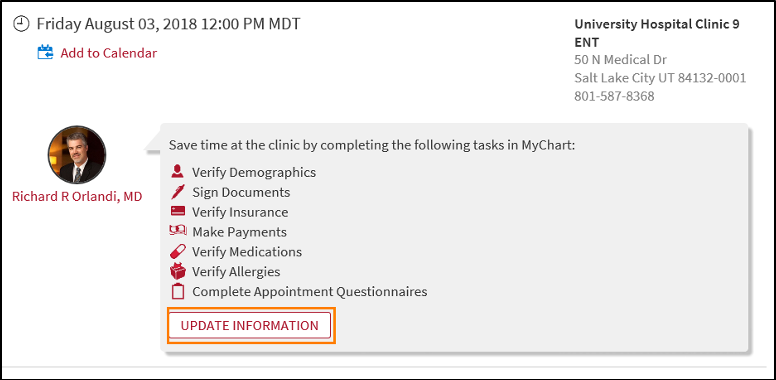
Complete Your Pre-Visit Checklist
Step 1: updating your information (demographic info).
After signing in to MyChart, you will verify your information. You have the chance to make any updates or changes in your information as well. These updates will then automatically update in our electronic medical records system.

Step 2: Sign Related Documents
After reviewing your information, you will have some documents to sign, such as the HIPAA agreement (privacy information).
If you choose to sign the forms later, you will have to complete them when you arrive for your appointment.
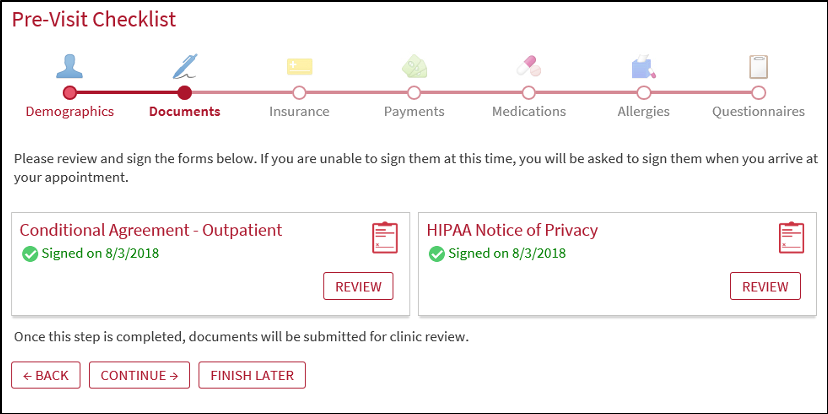
Step 3: Verify or Confirm Insurance Information
For this step you will need to review and confirm your insurance information. If you request any changes, we will process them after you have updated the information.

Step 4: Pay Your Copay
After you verify your insurance, you can pay the copay for the visit. If the copay amount is not correct, select Pay Copay Later. If you select Pay Copay Later, you can pay your copay at the clinic or health center.
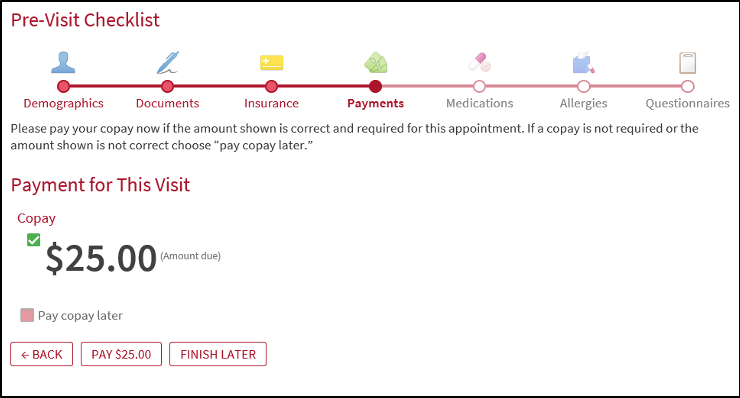
You will also have the option here to make a payment towards a previous balance on your account.
Don’t Have Insurance?
Learn about your options here .
Step 5: Verify or Update Medications, Allergies, and Your Medical History
In this step you can:
- review your medications,
- select a pharmacy,
- review any allergies, and
- review your medical history.
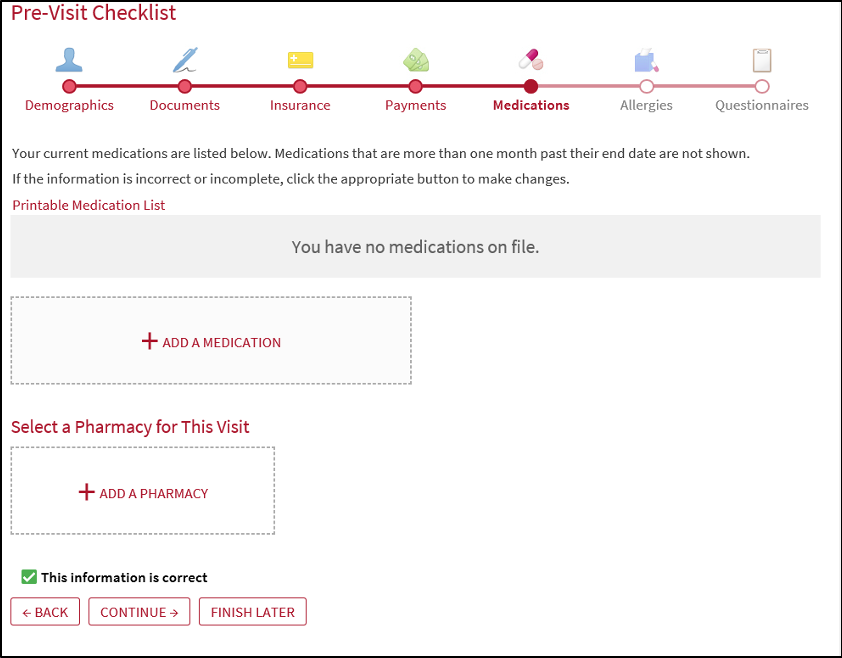
Step 6: Add or update allergies.
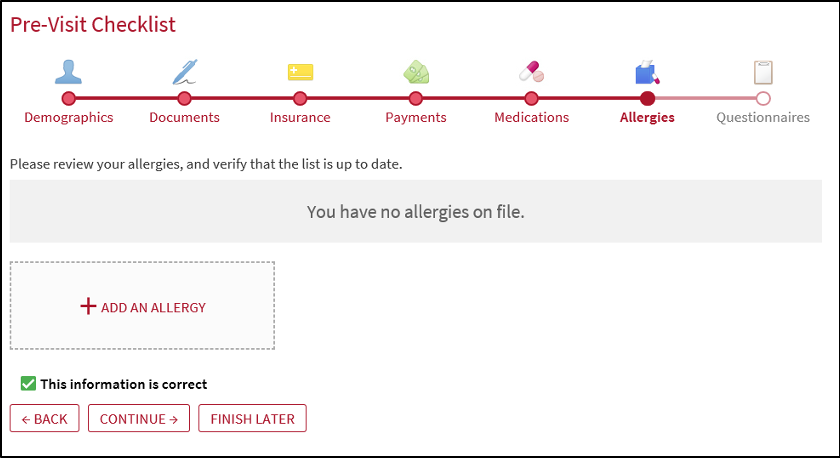
Medicare Coverage: Complete Medicare Secondary Payment Questionnaire if Needed
If you have Medicare coverage and have not completed the Medicare Secondary Payment Questionnaire, (MSPQ), you will have the option to complete it. If you don’t complete the MSPQ, you will need to complete it when you arrive at the clinic.
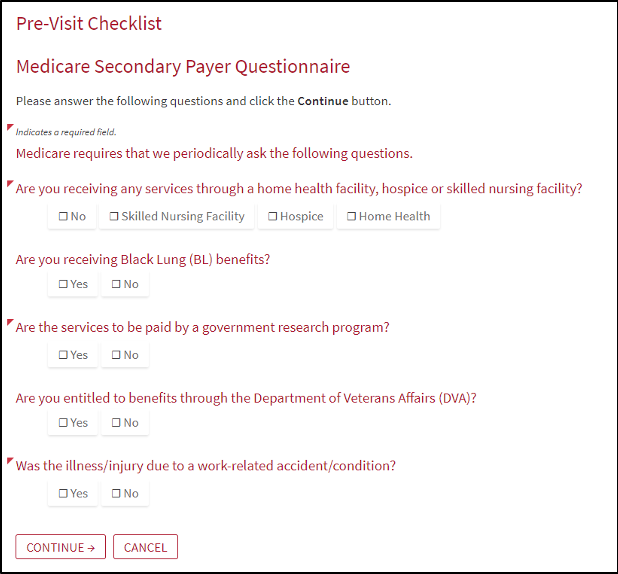
On the day of your appointment, when you arrive at the clinic, you can stop by the front desk or a kiosk. We will ask you to verify your identification by showing us a photo ID.

We look forward to seeing you at your appointment! If you need to cancel or reschedule your appointment, please call your health center or clinic.
Billing & Insurance
Doctor Visits
Get Your Medicare Wellness Visit Every Year

Take Action
If you have Medicare, be sure to schedule a yearly wellness visit with your doctor or nurse. A yearly wellness visit is a great way to help you stay healthy.
What happens during a yearly wellness visit?
First, the doctor or nurse will ask you to fill out a questionnaire called a health risk assessment. Answering these questions will help you get the most from your yearly wellness visit.
During your visit, the doctor or nurse will:
- Go over your health risk assessment with you
- Measure your height and weight and check your blood pressure
- Ask about your health history and conditions that run in your family
- Ask about other doctors you see and any medicines you take
- Give advice to help you prevent disease, improve your health, and stay well
- Look for any changes in your ability to think, learn, or remember
- Ask about any risk factors for substance use disorder and talk with you about treatment options, if needed
If you take opioids to treat pain, the doctor or nurse may talk with you about your risk factors for opioid use disorder, review your treatment plan, and tell you about non-opioid treatment options. They may also refer you to a specialist.
Finally, the doctor or nurse may give you a short, written plan to take home. This plan will include any screening tests and other preventive services that you’ll need in the next several years. Preventive services are health care services that keep you from getting sick.
Learn more about yearly wellness visits .
Plan Your Visit
When can i go for a yearly wellness visit.
You can start getting Medicare wellness visits after you’ve had Medicare Part B for at least 12 months. Keep in mind you’ll need to wait 12 months in between Medicare wellness visits.
Do I need to have a “Welcome to Medicare” visit first?
You don’t need to have a “Welcome to Medicare” preventive visit before getting a yearly wellness visit.
If you choose to get the “Welcome to Medicare” visit during the first 12 months you have Medicare Part B, you’ll have to wait 12 months before you can get your first yearly wellness visit.
Learn more about the “Welcome to Medicare” visit .
What about cost?
With Medicare Part B, you can get a wellness visit once a year at no cost to you. Check to make sure the doctor or nurse accepts Medicare when you schedule your appointment.
If you get any tests or services that aren’t included in the yearly wellness visit (like an extra blood test), you may have to pay some of those costs.
Who Can Get Medicare?
Medicare is a federal health insurance program. You may be able to get Medicare if you:
- Are age 65 or older
- Are under age 65 and have a disability
- Have amyotrophic lateral sclerosis (ALS), also called Lou Gehrig's disease
- Have permanent kidney failure (called end-stage renal disease)
You must be living in the United States legally for at least 5 years to qualify for Medicare. Answer these questions to find out when you can sign up for Medicare .
Make an Appointment
Take these steps to help you get the most out of your Medicare yearly wellness visit.
Schedule your Medicare yearly wellness visit.
Call your doctor’s office and ask to schedule your Medicare yearly wellness visit. Make sure it’s been at least 12 months since your last wellness visit.
If you're looking for a new doctor, check out these tips on choosing a doctor you can trust .
To find a doctor who accepts Medicare:
- Search for a doctor on the Medicare website
- Call 1-800-MEDICARE (1-800-633-4227)
- If you use a TTY, call Medicare at 1-877-486-2048
Gather important information.
Take any medical records or information you have to the appointment. Make sure you have important information like:
- The name and phone number of a friend or relative to call if there’s an emergency
- Dates and results of checkups and screening tests
- A list of vaccines (shots) you’ve gotten and the dates you got them
- Medicines you take (including over-the-counter medicines and vitamins), how much you take, and why you take them
- Phone numbers and addresses of other places you go to for health care, including your pharmacy
Make a list of any important changes in your life or health.
Your doctor or nurse will want to know about any big changes since your last visit. For example, write down things like:
- Losing your job
- A death in the family
- A serious illness or injury
- A change in your living situation
Know your family health history.
Your family's health history is an important part of your personal health record. Use this family health history tool to keep track of conditions that run in your family. Take this information to your yearly wellness visit.
Ask Questions
Make a list of questions you want to ask the doctor..
This visit is a great time to ask the doctor or nurse any questions about:
- A health condition
- Changes in sleeping or eating habits
- Pain or discomfort
- Prescription medicines, over-the-counter medicines, or supplements
Some important questions include:
- Do I need to get any vaccines to protect my health?
- How can I get more physical activity?
- Am I at a healthy weight?
- Do I need to make any changes to my eating habits?
Use this question builder tool to make a list of things to ask your doctor or nurse.
It can be helpful to write down the answers so you remember them later. You may also want to take a friend or relative with you for support — they can take notes, too.
What to Expect
Know what to expect at your visit..
The doctor or nurse will ask you questions about your health and safety, like:
- Do you have stairs in your home?
- What do you do to stay active?
- Have you lost interest in doing things you usually enjoy?
- Do you have a hard time hearing people on the phone?
- What medicines, vitamins, or supplements do you take regularly?
The doctor or nurse will also do things like:
- Measure your height and weight
- Check your blood pressure
- Ask about your medical and family history
Make a wellness plan with your doctor.
During the yearly wellness visit, the doctor or nurse may give you a short, written plan — like a checklist — to take home with you. This written plan will include a list of preventive services that you’ll need over the next 5 to 10 years.
Your plan may include:
- Getting important screenings for cancer or other diseases
- Making healthy changes, like getting more physical activity
Follow up after your visit.
During your yearly wellness visit, the doctor or nurse may recommend that you see a specialist or get certain tests. Try to schedule these follow-up appointments before you leave your wellness visit.
If that’s not possible, put a reminder note on your calendar to schedule your follow-up appointments.
Add any new health information to your personal health documents.
Make your next wellness visit easier by updating your medical information in the personal health documents you keep at home. Write down any vaccines you got and the results of any screening tests.
Medicare offers an online tool called MyMedicare to help you track your personal health information and Medicare claims. If you have your Medicare number, you can sign up for your MyMedicare account now .
Healthy Habits
Take care of yourself all year long..
After your visit, follow the plan you made with your doctor or nurse to stay healthy. Your plan may include:
- Getting important screenings
- Getting vaccines for older adults
- Keeping your heart healthy
- Preventing type 2 diabetes
- Lowering your risk of falling
Your plan could also include:
- Getting active
- Eating healthy
- Quitting smoking
- Watching your weight
Content last updated February 9, 2023
Reviewer Information
This information on Medicare wellness visits was adapted from materials from the Centers for Medicare and Medicaid Services
Reviewed by: Rachel Katonak Centers for Medicare and Medicaid Services Division of Policy and Evidence Review Coverage and Analysis Group
November 2022
You may also be interested in:

Stay Active as You Get Older: Quick Tips
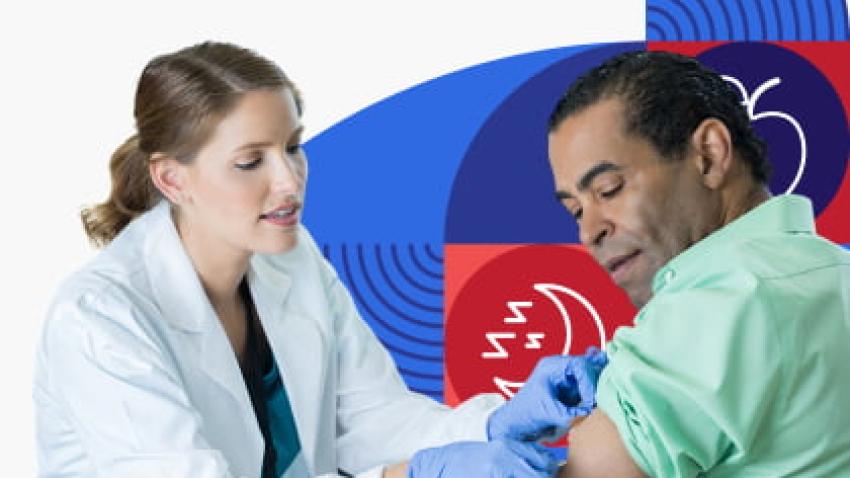
Get Vaccines to Protect Your Health (Adults Ages 19 to 49 Years)

Preventing Falls: Conversation Starters
The office of disease prevention and health promotion (odphp) cannot attest to the accuracy of a non-federal website..
Linking to a non-federal website does not constitute an endorsement by ODPHP or any of its employees of the sponsors or the information and products presented on the website.
You will be subject to the destination website's privacy policy when you follow the link.
The UCSF-John Muir Health Jean and Ken Hofmann Cancer Center at the Behring Pavilion is now open. LEARN MORE >
Doctor’s Office Visit Checklist
A little preparation can help you make the most of your appointment.
A visit to your doctor’s office may be a bit overwhelming, especially when there is a lot of information to exchange. Here are a few recommendations to help you make the most of your visit:
- Write down your questions prior to the appointment. Make a copy for yourself and your doctor. Remember to be realistic about what you can cover during the office visit, and prioritize the list. Having a list helps the physician recognize and address your major concerns.
- Bring an updated list of all your medications, and make a copy for your doctor. The list should include the names of the medications, the strength, the dose, the directions, reason for taking the medications, and name of the physician who prescribed them. Remember to also list non-prescription medications including herbal remedies. If possible, indicate how long you have been taking each medication. Here is a sample list that you may want to follow:
- Write down any symptoms you may have. "My back hurts" is very vague. Try to be as specific as possible. Is the pain to the right or left side lower or mid-back? Describe the type of pain: sharp or dull, constant or intermittent. How is pain affecting your daily routine? Are there situations or activities that cause or perpetuate the pain? How long have you been experiencing the pain? Finally, have you done anything to alleviate the pain, i.e., taking medication(s)?
- Bring an objective family member or friend to your appointment. They can help you recall the answers to your questions and any other information the physician may provide.
- Be prepared to remove shoes or clothing. If you're having a problem with your foot, wearing sandals or shoes that are easy to remove rather than lace-up shoes allows the physician more time to examine your foot and discuss your problem. Remember to wear comfortable clothes. A visit to your physician may sometimes cause a bit of anxiety, so the more relaxed you are the more you can get from the appointment.
- Office visits tend to run anywhere from 15- 30 minutes, so you must be realistic about what can be covered during this time. However, if you have multiple major issues, let your doctor's office know when you call to make your appointment. You may want to request an extended visit, or need to make two appointments.
- Preparing for a Doctor's Appointment
Doctor Visit Checklist
You may want to accompany your care recipient to doctor’s appointments. This way, you and your care recipient can work together as members of the health care team and ensure that you both understand the recommended medical course of action. This is an especially important role if your care recipient is cognitively impaired.
Here is a checklist to help you make the most of your doctor’s visit:
Doctor's Office Visit Checklist
Before the Visit
- Write down all questions or any concerns you might have so you don’t forget them. This will help you state them clearly. Regardless of how insignificant you feel the doctor may think it is– ASK!
- Identify current symptoms. Use the following handy symptom-reporting guide.
- Update the patient file and medication list . Be sure to include all medications, over the counter drugs and supplements.
- Call to confirm appointment
During the Visit
- Bring the updated medication list
- Clearly report all of your loved one’s symptoms; don’t try to diagnose the problem.
- Ask your questions and record the answers
- Record doctor's instructions
- Discuss recommendations
- Verify follow-up
After the Visit
- Review your notes
- Check prescriptions
- Discuss the visit
- Update your calendar
- Call for test results

COMMENTS
Take information with you to the doctor. Consider bringing a family member or friend to the doctor's visit. Keep your doctor up to date. Be sure you can see and hear as well as possible. Request an interpreter if you need one. A basic plan can help you make the most of your appointment whether you are starting with a new doctor or continuing ...
Dentist Checklist. Be prepared for your next visit to the dentist with this checklist: X-rays. Patients should get a complete set of X-rays every three to five years. During regular checkups—which should be scheduled every six months to a year—X-rays should be taken of individual teeth that may have cracks or cavities.
Before your appointment. Depending upon the reason for your doctor's visit, this checklist can help you prepare. Copies of any tests, x-rays, or medical histories relating to your medical problem. Completed medical history questionnaire. A list of all current medications taken on a regular basis, including over-the-counter and herbal medications.
Learn how to prepare for your doctor visit in advance, explain your symptoms and medical history, know your medications, be honest and open, and get the most out of your visit. The web page provides tips from medical experts and a checklist to help you prepare for your next doctor's appointment.
Prepare for Your Appointment. Write down everything you want to tell or ask the physician. Arrive early to your physician as you may need to complete forms. Bring a list of your symptoms (when they started, how long they last, how they feel, and where they are). Bring a list of any changes in your routine (for example: diet, exercise or ...
Learn how to prepare for your next doctor appointment, share your health and well-being, ask questions, take notes, follow through and stay in touch with your care team. CenterWell offers you a convenient way to stay healthy and well-informed with its monthly newsletter and resources.
The Today's Visit Form or Patient Pre-Visit Checklist can help you with preparing for your visit with your doctor. Talk to your doctor. When you talk to your doctor, follow these steps to make sure you and your doctor get the most out of your time together. Go over your lists.
Before Your Visit: Checklist Bring your insurance cards and any forms you need filled out. Make a list of things you want to talk to your doctor about and take it with you. o Preparing for Your Doctor's Visit Worksheet- PDF o Take Notes During Your Visit Worksheet - PDF
Below, see our complete checklist to prepare for your next appointment: Keep a symptom journal or diary. By writing down information about the onset of your symptoms, how frequently they take place, and what tends to make them worse, you'll help establish a thorough track record for your provider. You'll want the timeframe tobe from the ...
How to prepare for a doctor visit. You can do a few things ahead of your appointment to ensure your in-person visit goes smoothly. Anderson recommends packing a cloth face covering and some hand sanitizer for when you don't have immediate access to soap and water. It's also a good idea to write down your health conditions and the medications ...
In today's new normal, preparing for a doctor's visit may look a little different and require additional preparation. As COVID-19 increases social distancing across the U.S., it's no surprise that virtual medical appointments have seen a huge spike in popularity. Telemedicine isn't new, but it's been utilized more than ever during ...
Here are a few recommendations to help you make the most of your visit: Write down your questions prior to the appointment. Make a copy for yourself and your doctor. Remember to be realistic about what you can cover during the office visit, and prioritize the list. Having a list helps the physician recognize and address your major concerns.
doctor during your visit. Gather information and write down the following: o A list of any changes to your medical history since your last visit to your family doctor. This includes recent emergency department visit s or hospital stays, surgeries, new diagnoses, new medicine s, etc. o A list of any new challenges you are facing.
Worksheet: Life changes to discuss with your doctor. It's important to tell your doctor about any changes in your life since your last appointment. Use this worksheet to help you record what you want to discuss with your doctor during your next visit. View Worksheet 3: Changes to Discuss (PDF, 122K)
How to Prepare. A wellness visit is a health check-up that is typically conducted on an annual basis. It involves visiting your healthcare provider to check your vitals, screen for health conditions, and develop a healthcare plan for your needs. The aim of a wellness visit is to promote health and prevent disease and disability.
A well-child visit is a type of doctor's visit for kids. Children grow up quickly, and they can have changing health needs. It's important for their doctor to check their health and other aspects of their development. At your child's visit, the pediatrician will: 2. Do a head-to-toe exam; Take measurements, such as their height and weight
Any patient can complete their previsit checklist online. On the day of your appointment, when you arrive at the clinic, you can finish your check-in at the front desk or a kiosk. We will ask you to verify your identification by showing us a photo ID. You can complete your pre-visit checklist anywhere from seven days to 30 minutes before your ...
Your Doctor Visit Checklist. Your Doctor Visit Checklist. Make the most of your doctor's appointment. Here are some questions you should ask your doctor during your annual exam. 4. Topic. Questions to ask. Notes. Blood pressure.
Annual exams usually check your: History. This is your chance to mention any complaints or concerns about your health. Your doctor will also likely quiz you about lifestyle behaviors like smoking ...
Make a wellness plan with your doctor. During the yearly wellness visit, the doctor or nurse may give you a short, written plan — like a checklist — to take home with you. This written plan will include a list of preventive services that you'll need over the next 5 to 10 years. Your plan may include:
Tell your doctor you have ASD, and how to best to communicate with you. Give the doctor your N ew Physician Worksheet. Answer any questions he/she asks you to the best of your ability. During the Exam Tell the doctor why you have come to the clinic. Tell the doctor you have ASD and would like to have everything explained clearly
Here are a few recommendations to help you make the most of your visit: Write down your questions prior to the appointment. Make a copy for yourself and your doctor. Remember to be realistic about what you can cover during the office visit, and prioritize the list. Having a list helps the physician recognize and address your major concerns.
A checklist to help you prepare for and follow up on your care recipient's doctor's visit. Learn how to ask questions, report symptoms, update medication list, and communicate with the doctor and care recipient.
Do you have to travel far for basics such as groceries or a doctor's appointment? 6. Document your visit. When you're ready to see a home in person, download the Zillow app to request a tour and we'll match you with a local expert to schedule a showing. To prepare for your tour, head to your Touring Hub (you can find the Touring Hub by ...